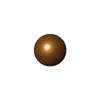+ Open data
Open data
- Basic information
Basic information
| Entry | Database: PDB / ID: 6ydd | |||||||||
|---|---|---|---|---|---|---|---|---|---|---|
| Title | X-ray structure of LPMO. | |||||||||
 Components Components | LPMO lytic polysaccharide monooxygenase | |||||||||
 Keywords Keywords | METAL BINDING PROTEIN / Lytic Polysaccharide Monooxygenase / Complex | |||||||||
| Function / homology |  Function and homology information Function and homology informationlytic cellulose monooxygenase (C4-dehydrogenating) / cellulose catabolic process / monooxygenase activity / extracellular region / metal ion binding Similarity search - Function | |||||||||
| Biological species |  Collariella virescens (fungus) Collariella virescens (fungus) | |||||||||
| Method |  X-RAY DIFFRACTION / X-RAY DIFFRACTION /  SYNCHROTRON / SYNCHROTRON /  MOLECULAR REPLACEMENT / Resolution: 2.8 Å MOLECULAR REPLACEMENT / Resolution: 2.8 Å | |||||||||
 Authors Authors | Tandrup, T. / Tryfona, T. / Frandsen, K.E.H. / Johansen, K.S. / Dupree, P. / Lo Leggio, L. | |||||||||
| Funding support |  Denmark, 1items Denmark, 1items
| |||||||||
 Citation Citation |  Journal: Biochemistry / Year: 2020 Journal: Biochemistry / Year: 2020Title: Oligosaccharide Binding and Thermostability of Two Related AA9 Lytic Polysaccharide Monooxygenases. Authors: Tandrup, T. / Tryfona, T. / Frandsen, K.E.H. / Johansen, K.S. / Dupree, P. / Lo Leggio, L. | |||||||||
| History |
|
- Structure visualization
Structure visualization
| Structure viewer | Molecule:  Molmil Molmil Jmol/JSmol Jmol/JSmol |
|---|
- Downloads & links
Downloads & links
- Download
Download
| PDBx/mmCIF format |  6ydd.cif.gz 6ydd.cif.gz | 102.9 KB | Display |  PDBx/mmCIF format PDBx/mmCIF format |
|---|---|---|---|---|
| PDB format |  pdb6ydd.ent.gz pdb6ydd.ent.gz | 77.2 KB | Display |  PDB format PDB format |
| PDBx/mmJSON format |  6ydd.json.gz 6ydd.json.gz | Tree view |  PDBx/mmJSON format PDBx/mmJSON format | |
| Others |  Other downloads Other downloads |
-Validation report
| Summary document |  6ydd_validation.pdf.gz 6ydd_validation.pdf.gz | 1.5 MB | Display |  wwPDB validaton report wwPDB validaton report |
|---|---|---|---|---|
| Full document |  6ydd_full_validation.pdf.gz 6ydd_full_validation.pdf.gz | 1.5 MB | Display | |
| Data in XML |  6ydd_validation.xml.gz 6ydd_validation.xml.gz | 19.4 KB | Display | |
| Data in CIF |  6ydd_validation.cif.gz 6ydd_validation.cif.gz | 26.3 KB | Display | |
| Arichive directory |  https://data.pdbj.org/pub/pdb/validation_reports/yd/6ydd https://data.pdbj.org/pub/pdb/validation_reports/yd/6ydd ftp://data.pdbj.org/pub/pdb/validation_reports/yd/6ydd ftp://data.pdbj.org/pub/pdb/validation_reports/yd/6ydd | HTTPS FTP |
-Related structure data
| Related structure data | 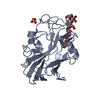 6ydcC  6ydeC  6ydfC  6ydgC  5achS S: Starting model for refinement C: citing same article ( |
|---|---|
| Similar structure data |
- Links
Links
- Assembly
Assembly
| Deposited unit | 
| ||||||||
|---|---|---|---|---|---|---|---|---|---|
| 1 | 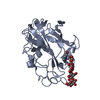
| ||||||||
| 2 | 
| ||||||||
| Unit cell |
|
- Components
Components
| #1: Protein | Mass: 27791.133 Da / Num. of mol.: 2 Source method: isolated from a genetically manipulated source Source: (gene. exp.)  Collariella virescens (fungus) / Gene: aa9 / Production host: Collariella virescens (fungus) / Gene: aa9 / Production host:  #2: Polysaccharide | beta-D-glucopyranose-(1-4)-beta-D-glucopyranose-(1-4)-beta-D-glucopyranose-(1-4)-beta-D-glucopyranose / beta-cellotetraose | #3: Polysaccharide | beta-D-glucopyranose-(1-4)-beta-D-glucopyranose / beta-cellobiose | #4: Chemical | #5: Water | ChemComp-HOH / | Has ligand of interest | Y | |
|---|
-Experimental details
-Experiment
| Experiment | Method:  X-RAY DIFFRACTION / Number of used crystals: 1 X-RAY DIFFRACTION / Number of used crystals: 1 |
|---|
- Sample preparation
Sample preparation
| Crystal | Density Matthews: 2.24 Å3/Da / Density % sol: 45.15 % |
|---|---|
| Crystal grow | Temperature: 298.15 K / Method: vapor diffusion, sitting drop / Details: 0.1 M NaCl, 0.1 M Bis-Tris pH 6.5, 2.0 M (NH4)2SO4 |
-Data collection
| Diffraction | Mean temperature: 100 K / Serial crystal experiment: N |
|---|---|
| Diffraction source | Source:  SYNCHROTRON / Site: SYNCHROTRON / Site:  ESRF ESRF  / Beamline: MASSIF-3 / Wavelength: 0.9 Å / Beamline: MASSIF-3 / Wavelength: 0.9 Å |
| Detector | Type: DECTRIS EIGER X 4M / Detector: PIXEL / Date: Apr 27, 2017 |
| Radiation | Protocol: SINGLE WAVELENGTH / Monochromatic (M) / Laue (L): M / Scattering type: x-ray |
| Radiation wavelength | Wavelength: 0.9 Å / Relative weight: 1 |
| Reflection | Resolution: 2.8→50 Å / Num. obs: 12356 / % possible obs: 98.2 % / Redundancy: 5.51 % / CC1/2: 0.969 / Net I/σ(I): 5.82 |
| Reflection shell | Resolution: 2.8→2.87 Å / Redundancy: 2.96 % / Mean I/σ(I) obs: 1.08 / Num. unique obs: 924 / CC1/2: 0.547 / % possible all: 99.1 |
- Processing
Processing
| Software |
| ||||||||||||||||||
|---|---|---|---|---|---|---|---|---|---|---|---|---|---|---|---|---|---|---|---|
| Refinement | Method to determine structure:  MOLECULAR REPLACEMENT MOLECULAR REPLACEMENTStarting model: 5ACH Resolution: 2.8→2.87 Å / Cross valid method: FREE R-VALUE
| ||||||||||||||||||
| Displacement parameters | Biso max: 47.88 Å2 / Biso mean: 13.814 Å2 / Biso min: 6.8 Å2 | ||||||||||||||||||
| Refinement step | Cycle: LAST / Resolution: 2.8→2.87 Å
|
 Movie
Movie Controller
Controller






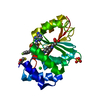





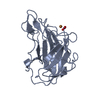
 PDBj
PDBj



